Isabel Ferrando’s Châteauneuf-du-Pape Old-Vine Grenache Is “The Heart Of Our Vineyards And The Soul Of Our Wine” (6-Bottle Assortment $329) + Recent Arrival Châteauneuf-du-Pape Vintage 2021, Seven Wines
To Blend or Not to Blend
The magic of the blend is the keystone in Châteauneuf-du-Pape’s rock-solid reputation; fifteen varieties are legally permitted in the appellation, and the proportion of each used in the final cuvée is a reflection of the vineyard’s potential, the estate’s philosophy and the vigneron’s artistry. The palette is juice, the canvas is the élevage and on opening day, and many years to come, the exhibition wears the familiar embossed insignia of a Châteauneuf-du-Pape bottle.
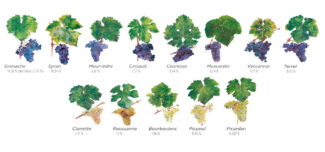
But is blending always the goal? Red wine comprises 95% of Châteauneuf-du-Pape’s output, and most of it is built around the Big Four—Grenache, Syrah, Mourvèdre and more recently, Cinsault. But as a quartet, they are hardly equal: As of 2014, 73% of the vineyards in the appellation were planted to Grenache, with Mourvèdre making up about 7% and Syrah, just under three percent—a number that may soon be supplanted by Cinsault as Syrah continues to lose popularity in the region. Even so, so dominant is Grenache in most blends that a winemaker would likely have to provide a vivisection of varietal profiles to explain how each trace addition affects the final cuvée. The blending spectrum in Châteauneuf-du-Pape, therefore, covers extremes: Château de Beaucastel frequently uses all the allowable grapes in their cuvée while another of Châteauneuf’s most important names, Château Rayas, uses only Grenache.
The Grenache
Despite its potential for splendor in the glass, Grenache has never made the leap into the rarified atmosphere of ‘noble grapes.’ But in the right hands, grown in the correct lieu-dit and farmed correctly, it can be as expressive of terroir as Pinot Noir and as complex and age-worthy as Cabernet Sauvignon. In Châteauneuf-du-Pape, it produces most favorably on sandy soils that provide delicacy and finesse, but where there is also limestone for structure, red clay for the development of rich (but not harsh) tannins and the small stones known as ‘galets’ for power. For a grape that produces such bold and muscular wines, Grenache is thin-skinned and not overly acidic, so it must be picked at an optimum period of phenolic ripeness to avoid becoming flabby and overly alcoholic. Vine age is of extreme importance for Grenache, with younger cultivars making pale-colored and often mediocre wines—60 -100 years appears to be an ideal age for the production of wine of consistently good quality.
The Grenachiste
Isabel Ferrando
If a Grenachiste is a loyalist who fights for Grenache, it would be hard to find a High Priestess more qualified than Isabel Ferrando. A former banker, she learned winemaking at Domaine Raspail-Ay in Gigondas deepened by the tutelage of the late legendary winemaker Henri Bonneau, and in 2003, purchased the seventy-year old Domaine Saint-Préfert from the Serre family, one of the region’s first domains to estate bottle. That year, the property stood at a little over thirty acres, all in the Les Serres lieu-dit south of the village of Châteauneuf.
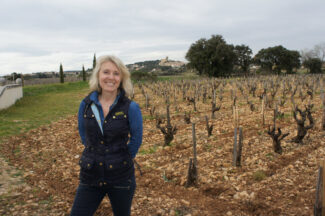
Isabel Ferrando, Domaine Saint Préfert
Once a successful first vintage was in the cellar, Ferrando began to purchase more land in CdP, expanding her holdings to its current 55 acres. Among her acquisitions was a small parcel of old-vine Grenache vines that became Domaine Isabel Ferrando ‘Colombis.’ Meanwhile, in 2013, Domaine Saint Préfert earned its certification for using 100% biodynamic farming, an agricultural technique that is somewhat easier pull off in Châteauneuf thanks to the sporadic but predictable Mistral winds that naturally protect vines from pests and mildew.
Still, it is Ferrando’s ever-growing expertise and hands-on winemaking that produces her outstanding portfolio. Says ‘The Grenachiste’: “There is no secret formula to making great wines in Châteauneuf. I work with a young team who is always open to new ideas. We rely on tradition without being trapped by it, working with whole-cluster fermentations without added yeasts because we discovered that it increased freshness in the wines and lowered alcohol, giving the wines vibrancy. Aging occurs in a mix of concrete and used foudres for up to 18 months.”
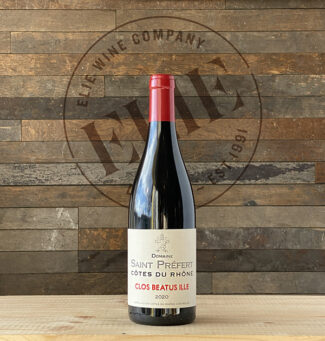 Domaine Saint Préfert, Côtes-du-Rhône ‘Clos Beatus Ille’ 2020 ($30)
Domaine Saint Préfert, Côtes-du-Rhône ‘Clos Beatus Ille’ 2020 ($30)
(Two Bottles)
‘Beatus Ille’ is Latin for ‘Happy Man’—it’s a line from Horace’s 2nd Epode and no doubt includes happy women as well. The wine is 85% Grenache blended with about 15% Cinsault from two parcels—La Lionne in the Sorgues district, just at the southern border of Châteauneuf-du-Pape and another parcel in Vedène. It also contains a bit of Syrah from Châteauneuf-du-Pape. A supple and affordable entryway into Isabel Ferrando’s world, the wine shows the traits of the great Crus in Southern Rhône in an approachable package; cassis, plum and fresh red berries with hints of Asian spice and truffles.
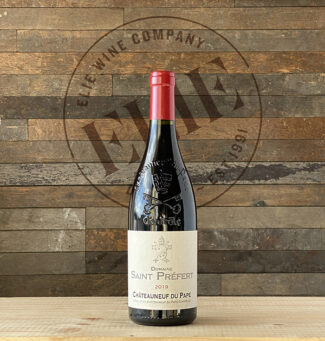
Domaine Saint Préfert, Châteauneuf-du-Pape ‘Classique’ 2019 ($53)
(Two Bottles)
With a base cuvée of 85% Grenache and 5% each of Syrah, Mourvèdre, and Cinsault, aged entirely in concrete tanks, is classic varietal choice as well as in name. Vinified from middle-aged vines—30 years old, tops—this wine is an expression of exuberance crammed with juicy raspberry and bright cherry and light hints of licorice. The sharp subcurrents of smoke and minerality provide a clue that these vines, and the wines they produce, will continue to improve with age.
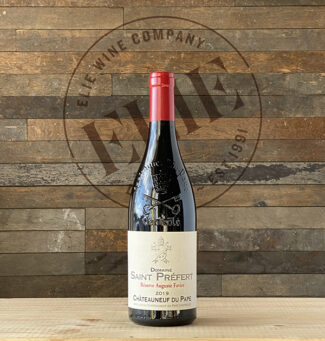 Domaine Saint Préfert, Châteauneuf-du-Pape ‘Réserve Auguste Favier’ 2019 ($82)
Domaine Saint Préfert, Châteauneuf-du-Pape ‘Réserve Auguste Favier’ 2019 ($82)
(One Bottle)
The eponymous August Favier was Isabel Ferrando’s maternal grandfather; the lieu-dit that produces this blend— 85% Grenache and 15% Cinsault—is also named for an original owner. Les Serres, a vineyard in the southernmost part of Châteauneuf-du-Pape, takes its name from Fernand Serre, who planted it in 1928. The grapes are hand-picked and vinified separately; the Grenache is aged in cement and the Cinsault in 600-liter barrels. Floral and exotic, the wine expresses a full-bodied core of blackberry draped with a lacy texture throughout, showing rich cassis and raspberry coulis flecked with the garrigue herbs that are native to the area. A long, elegant finish with a surprisingly silky tannic edge.
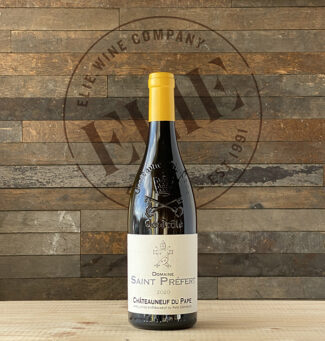 Domaine Saint Préfert, Châteauneuf-du-Pape Blanc 2020 ($82)
Domaine Saint Préfert, Châteauneuf-du-Pape Blanc 2020 ($82)
(One Bottle)
This wine is a blend of 60% Clairette and 40% Roussanne, and is moderately acidic with a nose that displays honeysuckle, acacia flower and peach. The Roussanne lends a rich tannic structure while the Clairette offers minerality and the region’s characteristic salinity.
The Package …
This week’s package offering is comprised of the four wines featured above: Two of each of Côtes-du-Rhône and Châteauneuf-du-Pape ‘Classique’, and one of each of ‘Collection Charles Giraud’ and ‘Blanc’ for a total of six bottles at $329. The quantity of each included is, also, indicated in the write-up about the wine.
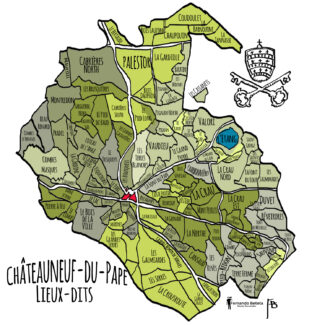
Also, from Domaine Saint Préfert
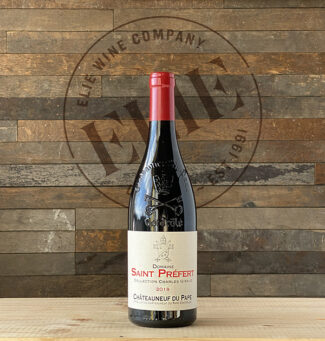 Domaine Saint Préfert, Châteauneuf-du-Pape ‘Collection Charles Giraud’ 2019 ($159)
Domaine Saint Préfert, Châteauneuf-du-Pape ‘Collection Charles Giraud’ 2019 ($159)
60% Grenache, 35% Mourvèdre and 5% Syrah, Isabel Ferrando’s ‘tête de cuvée’ is made from the oldest vines in two parcels—les Serres and le Cristia. The former features the famous, multipurpose galet stones of Châteauneuf that retain heat and night and protect the soil from erosion. Le Cristia is a sandy block with drainage ideal for Mourvèdre’s root system, which does not produce well otherwise. The wine shows concentrated boysenberry and violet pastille and candied fruit and bright, chewy back-end lift. As Auguste Favier was Isabel Ferrando’s maternal grandfather, Charles Giraud was her father’s father.
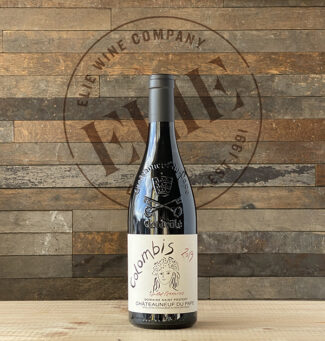 Domaine Préfert (Isabel Ferrando), Châteauneuf-du-Pape ‘Colombis’ 2019 ($159)
Domaine Préfert (Isabel Ferrando), Châteauneuf-du-Pape ‘Colombis’ 2019 ($159)
Isabel Ferrando affixes her name to the mono-varietal wines she produces at Domaine Préfert. ‘Colombis’ is 100% Grenache, but a blend from three parcels in the western part of the appellation: Lieu-dit Colombis, featuring sandy soils, les Roues, where clay lies just beneath the surface, and le Cristia (not far from Château Rayas), where sand again predominates. The vines average 60 years-old and the concentrated juice from the small clusters produce a wine that critic Jeb Dunnuck referred to as “One of my favorite wines in the world.” Expansive in bouquet and again on the palate, the wine shows spice-accented currant preserves with incense and cola with crisp mineral undertones and an intensely long finish framed by velvety, well-integrated tannins.
The Exception in ‘Vin d’Exception’ : Pure Cinsault, Pure Audacity
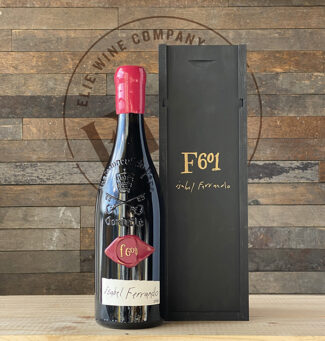 Domaine Préfert (Isabel Ferrando), Châteauneuf-du-Pape ‘F601’ 2018 ($850)
Domaine Préfert (Isabel Ferrando), Châteauneuf-du-Pape ‘F601’ 2018 ($850)
‘F601’ may sound like an unpoetic name for a lieu-dit, and in fact, it is an arid block in the southern part of the estate. It is also atypical of the terroirs of Châteauneuf-du-Pape; fifteen feet below the surface, sand made of degraded quartz can be found and a bit higher up, extra moisture is lodged in a fine layer of blue clay fed by the mica gravel and rolled pebbles already visible at ground level. Of this remarkable habitat for Cinsault Isabel Ferrando writes, “I needed 16 years of observation and apprenticeship to find the audacity to throw away the rule book and forge a personal relationship with this terror, guided by instinct and sensuality. With the 2018 vintage, I am launching ‘F601, and for the first time, the pure and absolute expression of the fusion between this block of land and the venerable Cinsault vines planted on it in 1928. At this defining moment in my life, I am happy to share with you my sense of wonder in this iconic Châteauneuf-du-Pape. Welcome to F601!”
Rich And Rare: White Châteauneuf-du-Pape en Magnum
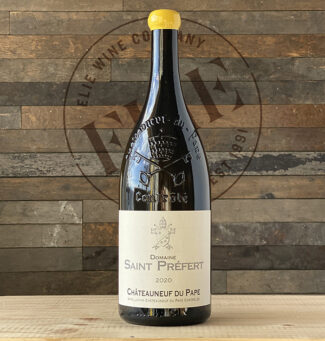 Domaine Saint Préfert, Châteauneuf-du-Pape Blanc 2020 ($189) – 1500 ml
Domaine Saint Préfert, Châteauneuf-du-Pape Blanc 2020 ($189) – 1500 ml
Before the wine, why the magnum? Surface area plays a tremendous role in the changes that a wine undergoes during élevage and later, ‘en bouteille’, and these changes happen at a rate that is in proportion to the size of the container. In a magnum—roughly twice the size of a conventional wine bottle—the aging process is slowed down and the wine will keep fresher longer; a plus if the wine is white. This wine is a blend of 60% Clairette and 40% Roussanne from the Serres lieu-dit, where galets, gravel and blue clay abound. It ages on lees for six months in large oak barrels, one third of which is new, one third year-old and the last third two year-old barrels. Moderately acidic, the nose shows honeysuckle, acacia flower and peach with the Roussanne lending a rich tannic structure and the Clairette offering minerality and the region’s characteristic salinity.
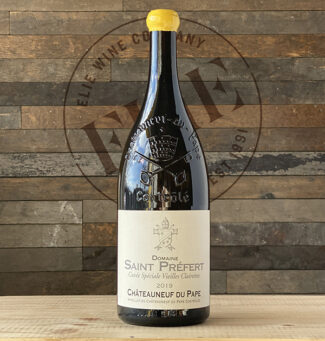 Domaine Saint Préfert, Châteauneuf-du-Pape Blanc ‘Cuvée Spéciale Vieilles Clairettes’ 2019 ($432) – 1500 ml
Domaine Saint Préfert, Châteauneuf-du-Pape Blanc ‘Cuvée Spéciale Vieilles Clairettes’ 2019 ($432) – 1500 ml
Only produced ‘en magnum’, this is a heavily allocated gem with less than a thousand bottles made and even fewer exported. 100% Clairette from 100-year-old vines in the dry-farmed lieu-dit ‘Quartier des Serre’ renowned for being one of the most sun-drenched plots in the appellation as well as nurturing vines in well-drained, river-rolled pebble soil. An exquisite, unctuous expression of an under-appreciated varietal, the wine reflects both sun and sand with warm notes of honey, quince jam, creamy lemon curd and pink grapefruit acidity as a backbone.
Notebook …
Vintage 2018
The quintessence of a year that the old winemaker’s cliché refers to ‘a vintage made in the vineyard’—based on the difficulty that growers had bringing in the harvest. Rains in May and June created a poor fruit set for Grenache, and the threat of mildew was redoubled by the failure of the mistral; a rare occurrence in Châteauneuf-du-Pape. Humidity skyrocketed, making 2018 the dampest year since 1973, and organic farmers grew frustrated that natural treatments were washed away by un-forecasted rain. The result was a harvest that in particular showed a 40%-60% reduction in Grenache. Syrah and Mourvèdre fared better, and these varieties tend to be more pronounced in the blends.
Vintage 2019
Grenache, however, enjoyed a marvelous renaissance in 2019, and for this sun, heat and wind-loving varietal, the vintage was ideal. An abundant fruit set was followed by three heat waves interspersed with rain and more moderate temperatures, and as a result, there was no heat stress for the vines, and ripening never shut down. Growers were able to pick at optimum ripeness and nothing much had to be done in the vineyard. The fruit’s health carried through to the cellar, with many growers reporting that their vinification were fast and efficient.
Vintage 2020
Following the extreme heat of 2019, growers were hoping for plenty of rainfall over the winter to replenish aquafers, and they got it. An astonishing 15 -20 inches of rain fell between October and December, and a mild early spring saw vine buds break nearly two weeks earlier than 2019. The summer was hot, but not unreasonably so; rains were moderate and frequent enough to prevent heat stress. Harvest for white grapes began in the third week of August, and the 2020 vintage is extremely strong in this category, however small (only 5% of Châteauneuf-du-Pape’s total). It is characterized by elegance and beauty, with a nose marked by citrus and stone fruit and a palate that combines balanced acidity with a prolonged finish.
RECENT ARRIVAL
A Question of Vintage
The vagaries of vintage are both a charm and a curse to winemakers, who routinely dream of abundance and quality. Most labels feature the vintage prominently, and serious wine people track and compare the results with other vintages. Vintage, of course, refers to the year in which the grapes were grown and is generally not the same year that the wine was bottled; vintage is as vital a piece of information as the name of the producer. In fact, there’s even a grading system: The Compagnie des Courtiers Jurés-Experts Piqueurs de Vins (The Guild of the Sworn Intermediary Wine Tasters) is a group of specialists that has existed for 700 years; in 1940, they began scoring wine based on a vintage chart, and today their much-sought-after, pocket-sized guide may be found online.
Lackluster harvests are particularly tough on monovarietal wines—wines made from a single type of grape, as is the case in much of Burgundy and the Loire. When a vigneron sets out to create an assemblage, however, in regions where AOP laws allow winemakers a certain leeway to portioning several varieties into a final blend, there is a unique set of decisions to be made. A given varietal may do better than another, and the percentage information—often listed on tech sheets but rarely on the bottle—become a source of knowledge as important as the vintage.
This week’s recent arrivals include selections from Châteauneuf-du-Pape in a difficult vintage, 2021. 18 different grapes are permitted under the Châteauneuf-du-Pape AOP regulations, and it is fair to say that some varieties fared better than others. This is where art of blending reaches its apogee, and where we find that the variance of vintage may create a number of unexpected masterpieces when winemakers are required to dig deeply into their tool-box to build a presentable product.
2021 was such a vintage, and as such, it has been referred to as ‘The Year of the Vigneron.’
Châteauneuf-du-Pape Vintage 2021
Year of The Vigneron
‘Precocious’ is a dangerously loaded word, whether it is used to describe a child or a vintage. It generally means that things are happening out of sequence, earlier than is usual. 2021 was such a season in Southern Rhône, and the rumbles of discontent began the year before. Autumn, 2020, was mild and damp and the season remained so until a short cold spell happened in January ʼ21. In February, Saharan winds brought unseasonable highs that reached into the mid-60s°F, advancing the vegetative cycle throughout the vineyards. Vines, if not growers, love these unseasonable warm spells, leaving them easy targets for one of a vigneron’s worst nightmares— spring frost. Sure enough, during the first week of April, a catastrophic frost lambasted the vineyards and across Châteauneuf-du-Pape, reports indicated potential losses of up to 80%. The double-whammy of frost is not only seen in the damage it inflicts at the time, but that it leaves grapes weaker and more susceptible to fungal disease in the weeks to come. To aggravate this latter risk, the rest of the spring was humid, with heavy rains accompanied by cooler temperatures and less than average sunshine, raising fears of coulure (uneven ripening).
In Châteauneuf-du-Pape, the catastrophe saw a 70% reduction in yield in a few spots, but overall, the impact was meliorated by the proximity of the Rhône River. Even so, in 2021, the skill of the winemaker came to the forefront. Every vigneron in the appellation had issues to deal with and questions to consider, including the use of whole bunch (weighing its aromatic benefits against the risk of underripe stalks), the amount of oak to use, how strictly to sort grapes, and in particular, how much to alter their blend in the varieties or vineyard plots they could draw from.
It is fair to say that the best domains did splendidly, creating wines in classical CdP style, meaning, possessed of exceptional elegance and incipient freshness, fruit not bogged down by alcohol. Managed well, cooler temperatures permit a long, slow ripening period and produce grapes with full phenolic ripeness but lower sugars. This leaves alcohol levels blissfully low compared to recent averages, and a welcome change to some of the headier wines of some vintages.
It can be argued that 2021 is not a vintage to cellar extensively, although the higher acid levels still work in favor of longevity. Perhaps this is a vintage to enjoy young, and to celebrate the Year of the Vigneron with tonight’s meal.
Domaine Charvin
Among Laurent Charvin’s several ‘claims to fame’ is the fact that up until recently, he was the only producer in Châteauneuf-du-Pape to vinify traditionally, using whole-cluster fermentation and to élevage in concrete (rather than oak) for 21 months prior to bottling. Working with about 25 acres within that hallowed appellation, he is known for producing elegant and CdPs that check all the boxes for the ideal balance between finesse and power.
Also somewhat unique to Charvin is the sharply acidic little grape Vaccarèse, which makes up about 5% of his blends. It’s a variety well-suited to his particular terroir, which is somewhat sandier than many and helps define his cuvées by lending more perfume, minerality and elegance.
Says Charvin: “Our main concern is always our work in the vineyards. In the cellar, it is surprisingly easy to spoil the harvest and not repair very much. In our favor is our old vines, averaging 60 years, and our approach to farming; these vineyards have been certified ‘agriculture biologique’ since 2014.”
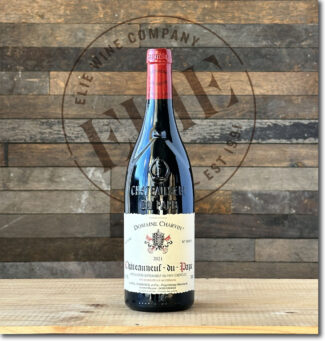 Domaine Charvin, 2021 Châteauneuf-du-Pape ($73)
Domaine Charvin, 2021 Châteauneuf-du-Pape ($73)
82% Grenache, with the balance divided between Mourvèdre, Vaccarèse, Syrah and Counoise. In the 2021 vintage, production was down 40%, meaning there is not much to go around, but the bottles we scored shows a wine with luscious aromas of forest fruit—raspberry, blueberry and wild strawberry—woven into a rose-petal core. On the palate it is distinctively elegant and telegraphs freshness rather than weight, with a lot of peppery fruit that stays in focus through the finish. It’s fine to drink immediately (given a little time to breathe) but should store well for at least another decade.
Domaine de Ferrand
Philippe Bravay is a winemaker who makes mountains of molehills: Domaine de Ferrand covers a lilliputian 17 acres in Châteauneuf-du-Pape vineyards spread over six parcels in four lieux-dits. Half of his vines are 45 years old and the rest are 95 to 110. In order to maximize the potential available to him, Bravay relies upon organic growing techniques and limits yields strictly.
Philippe’s vinification philosophy and practice is the same for all his wines: “I do not use barriques because I want the wine of my vines and not a technical élevage which loses the origins of the wine. There is no filtration, only one fining for each wine. During the aging, the wine is neither racked nor blended, which is done only at the time of bottling and without the addition of preservatives.”
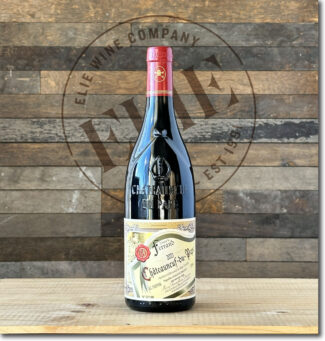 Domaine de Ferrand, 2021 Châteauneuf-du-Pape ($63)
Domaine de Ferrand, 2021 Châteauneuf-du-Pape ($63)
90% Grenache; 10% field blend. The wine exudes the sensuous, savory delicacy of a young, old-school CdP, with crushed violet on the nose with juicy cherry, raspberry and strawberry defining the fruit and a ferrous note of crushed rocks, garrigue and white pepper shoring up the herbal and mineral face of the profile.
Chapelle St. Théodoric
Chapelle St. Théodoric may be an odd egg, but it’s Fabergé-egg odd. For starters, it’s new—its first vintage was 2009 and it produces only 100% Grenache cuvées. Even its name is a bit of a misnomer, since it has nothing to do with Chapelle St. Théodoric, a thousand-year-old chapel that sits in the center of Châteauneuf-du-Pape at Avenue Baron le Roy.
Instead, the winery is the brainchild of two wine authorities, Domaine de Cristia owner Baptiste Grangeon and American wine importer Peter Weygandt. Their goal was to show the different expression of old-vine Grenache grown in two similar, but unique lieux-dits—Guigasse and Pignan. These areas boast sandy soils nearly stone-free and contain only Grenache vines with an average age of 50 years; some vines are more than a hundred.
The vines are overseen using biodynamic principles and the wine made by the team at Domaine de Cristia.
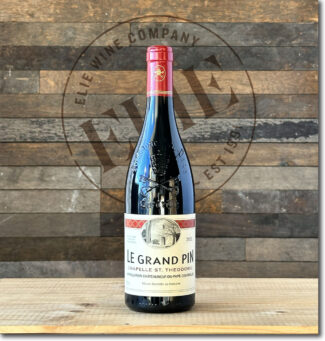 Chapelle St. Théodoric ‘Le Grand Pin’, 2021 Châteauneuf-du-Pape ($108)
Chapelle St. Théodoric ‘Le Grand Pin’, 2021 Châteauneuf-du-Pape ($108)
From 35-year-old vines in the Pignan lieu-dit, vinified as whole clusters and then aged 24 months in older demi-muids. This 100% Grenache is ruby-hued and offers a nuanced bouquet of mulled red and black fruits, cured meats, spring flowers, and ground pepper. The Northern-Rhône-like gaminess is flanked by mineral, chalky notes and a touch of pine sap at the finish.
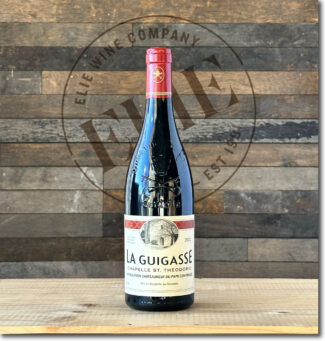 Chapelle St. Théodoric ‘La Guigasse’, 2021 Châteauneuf-du-Pape ($99)
Chapelle St. Théodoric ‘La Guigasse’, 2021 Châteauneuf-du-Pape ($99)
From 75-year-old Grenache grown in the sandy soils of Guigasse; the wine was fermented as whole clusters and spent two years in older demi-muids. Newly released, it demonstrates an intriguing spiciness on the nose, with herbal notes to provide a compelling counterpoint to the cherry and raspberry. Considered by some to be ‘the wine of the vintage.’
Domaine Raymond Usseglio
The Usseglio clan, with wine roots in Italy even before the patron Francis moved to Rhône in 1931, produce (under several domain names) some of the best Châteauneuf-du-Pape on the market. So many labels in the region bear the Usseglio name that it is a chore to keep them separate.
Raymond, one of two winemaking sons of Francis, created this estate in 1964 and began producing wine under his own name immediately, a somewhat rare practice in the era. Of the domain’s 45 acres of vines in CdP, eight are used for white wines, the rest devoted to red. These vines are beautifully situated in two locations, half in the famous La Crau vineyard, with the remaining vines situated close to the ancient castle of the Pope in the lieux-dits l’Arnesque, Bois Senechaux, Cabrières, Carbonnières, Palestor, les Terres Blanches and le Tresquoys.
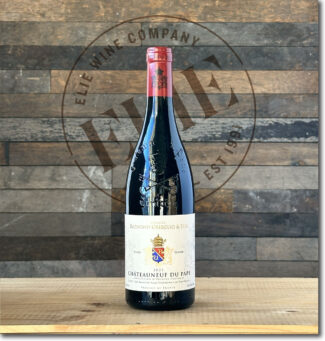 Domaine Raymond Usseglio ‘Cuvée Girard’, 2021 Châteauneuf-du-Pape ($49)
Domaine Raymond Usseglio ‘Cuvée Girard’, 2021 Châteauneuf-du-Pape ($49)
Due to the weather throughout the growing season, Raymond used a higher proportion of old vine fruit in his entry-level cuvée, giving weight and velvety richness to the blend. Mostly Grenache with a balance of Mourvèdre, Counoise and tiny amounts of Syrah and Cinsault, all underwent whole cluster fermentation. The vines are from several areas in Châteauneuf, but predominantly Les Terres Blanches, Bois Senechaux and La Crau, all north to east of the village itself. 10% of the Girard is from 120-year-old vines, and all varieties are concrete-aged except for the Mourvèdre, which is aged in barrique and blended at the final assemblage. The wine is a fragrant spice box, with ripe black cherry, mint and a pinch of white pepper.
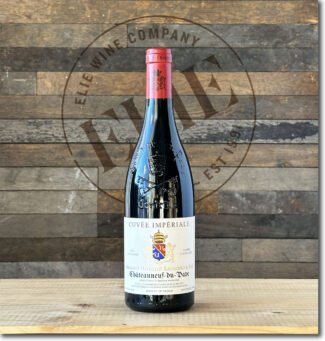 Domaine Raymond Usseglio ‘Cuvée Impériale – Vignes Centenaires’, 2021 Châteauneuf-du-Pape ($87)
Domaine Raymond Usseglio ‘Cuvée Impériale – Vignes Centenaires’, 2021 Châteauneuf-du-Pape ($87)
From old vines grown in two sandy parcels, Pied-Long (sand on red clay and galets roulés) and one in the more famous la Crau. For various reasons (some unexplainable), fruit from Pied-Long ripens about two weeks later than La Crau, giving it an immediate advantage, as a slow ripening process allows grapes to gain in complexity. The wine shows exotic aromas of orange zest, Campari-like spice and exquisitely ripe cherries while the full-bodied palate is silky in texture remaining airy and vibrant through a long, zesty finish.
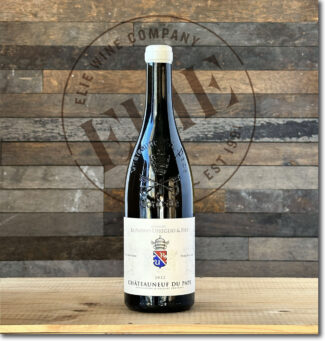 Domaine Raymond Usseglio ‘Pure Roussane’, 2022 Châteauneuf-du-Pape Blanc ($68)
Domaine Raymond Usseglio ‘Pure Roussane’, 2022 Châteauneuf-du-Pape Blanc ($68)
100% Roussanne, a grape with naturally low yields. Usseglio has planted these vines partly on sandy soils and partly in a terroir where clay and loam are interspersed with the area’s famous galets. The combination of terroirs produces a wine with all depth and finesse and a concentrated Roussanne profile: Quince and linden flowers on the nose, and on the palate, lemon and orange zest, green herbs and ripe apricot perfectly balanced with an elegant acidity on a long finish.
- - -
Posted on 2024.01.20 in Châteauneuf-du-Pape, France, Wine-Aid Packages, Southern Rhone
Featured Wines
- Notebook: A’Boudt Town
- Saturday Sips Wines
- Saturday Sips Review Club
- The Champagne Society
- Wine-Aid Packages
Wine Regions
Grape Varieties
Albarino, Albarín Blanco, Albarín Tinto, Albillo, Aleatico, Aligote, Arbanne, Aubun, Barbarossa, barbera, Biancu Gentile, bourboulenc, Cabernet Franc, Caino, Caladoc, Calvi, Carcajolu-Neru, Carignan, Chablis, Chardonnay, Chasselas, Cinsault, Clairette, Corvina, Counoise, Dolcetto, Erbamat, Ferrol, Frappato, Friulano, Fromenteau, Gamay, Garnacha, Garnacha Tintorera, Gewurztraminer, Graciano, Grenache, Grenache Blanc, Groppello, Juan Garcia, Lambrusco, Loureira, Macabeo, Macabou, Malbec, Malvasia, Malvasia Nera, Marcelan, Marsanne, Marselan, Marzemino, Mondeuse, Montanaccia, Montònega, Morescola, Morescono, Moscatell, Muscat, Natural, Niellucciu, Parellada, Patrimonio, Pedro Ximénez, Petit Meslier, Petit Verdot, Pineau d'Aunis, Pinot Blanc, Pinot Gris, Pinot Meunier, Pinot Noir, Pouilly Fuisse, Pouilly Loche, Poulsard, Prieto Picudo, Riesling, Rondinella, Rose, Rousanne, Roussanne, Sagrantino, Sauvignon Blanc, Savignin, Sciacarellu, Semillon, Souson, Sparkling, Sumoll, Sylvaner, Syrah, Tannat, Tempranillo, Trebbiano, Trebbiano Valtenesi, Treixadura, Trousseau, Ugni Blanc, vaccarèse, Verdicchio, Vermentino, Xarel-loWines & Events by Date
- July 2024
- June 2024
- May 2024
- April 2024
- March 2024
- February 2024
- January 2024
- December 2023
- November 2023
- October 2023
- September 2023
- August 2023
- July 2023
- June 2023
- May 2023
- April 2023
- March 2023
- February 2023
- January 2023
- December 2022
- November 2022
- October 2022
- September 2022
- August 2022
- July 2022
- June 2022
- May 2022
- April 2022
- March 2022
- February 2022
- January 2022
- December 2021
- November 2021
- October 2021
- September 2021
- August 2021
- July 2021
- June 2021
- May 2021
- April 2021
- March 2021
- February 2021
- January 2021
- December 2020
- November 2020
- October 2020
- September 2020
- August 2020
- July 2020
- June 2020
- May 2020
- April 2020
- March 2020
- February 2020
- January 2020
- December 2019
- November 2019
- October 2019
- September 2019
- August 2019
- July 2019
- June 2019
- May 2019
- April 2019
- March 2019
- February 2019
- January 2019
- December 2018
- November 2018
- October 2018
- September 2018
- August 2018
- July 2018
- June 2018
- May 2018
- April 2018
- March 2018
- February 2018
- January 2018
- December 2017
- November 2017
- October 2017
- September 2017
- August 2017
- July 2017
- June 2017
- May 2017
- April 2017
- March 2017
- February 2017
- January 2017
- December 2016
- November 2016
- October 2016
- September 2016
- August 2016
- July 2016
- June 2016
- May 2016
- April 2016
- March 2016
- February 2016
- January 2016
- December 2015
- November 2015
- October 2015
- September 2015
- August 2015
- July 2015
- June 2015
- May 2015
- April 2015
- March 2015
- February 2015
- January 2015
- December 2014
- November 2014
- October 2014
- September 2014
- August 2014
- July 2014
- June 2014
- April 2014
- March 2014
- February 2014
- January 2014
- December 2013
- November 2013
- October 2013
- September 2013
- August 2013
- July 2013
- June 2013
- May 2013
- April 2013
- March 2013
- February 2013
- January 2013
- December 2012
- November 2012
- October 2012
Search



